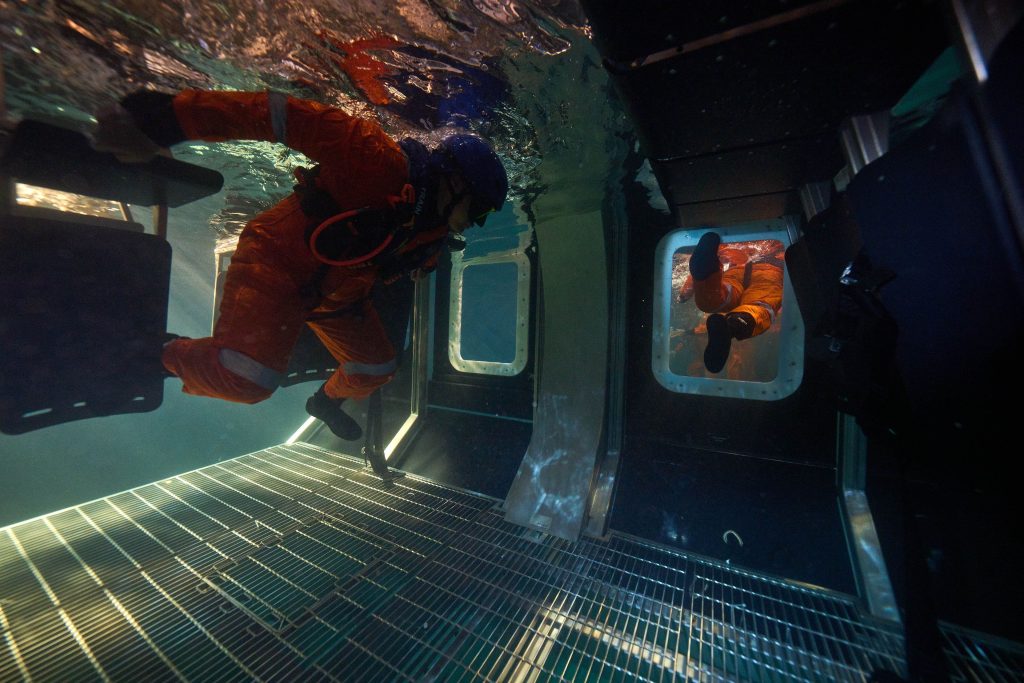HUET (Helicopter Underwater Escape Training)
If your responsibilities involve traveling to and from offshore oil and gas installations and vessels by helicopter, choosing OPITO accredited Helicopter Underwater Escape Training (HUET) with an Emergency Breathing System (EBS) is essential. This training program is designed to equip personnel with the necessary skills to use safety equipment and adhere to procedures during helicopter emergencies. With a specific emphasis on underwater escape following ditching scenarios, this accredited HUET training ensures individuals are well-prepared to handle and navigate through critical situations, enhancing overall safety and preparedness in offshore environments.

1-Day
- Physical/Off Campus
Topics Covered – Helicopter Underwater Escape Training (HUET) with Emergency Breathing System (EBS)
Helicopter Safety and Escape
Helicopter Travel
Helicopter Emergencies
All delegates must deploy and operate the EBS and must be encouraged to breathe from the EBS throughout the capsize exercises.
Training activities outlined in this standard may involve physically demanding and potentially stressful components. All individuals engaging in such activities must be physically fit and capable of full participation. Therefore, delegates either
Possess a valid offshore medical certificate or
Possess an operator-approved medical certificate or
Undergo medical screening via OPITO-provided form
This training program is designed to meet the safety and emergency response training requirements for individuals new to or re-entering the offshore oil and gas industry, who will be equipped with a rebreather emergency breathing system (EBS) during offshore helicopter travel.
Practical
- Donning an aviation transit suit, aviation lifejacket and emergency breathing system equipment (EBS) and conducting EBS integrity checks.
- Actions to take in preparation for a helicopter ditching and an emergency landing.
- Actions following a controlled emergency descent to a dry landing with evacuation via a nominated exit.
- Deployment, operation and breathing from EBS in a pool utilising personal air prior to HUET exercises (delegate to experience positive and negative pressure created by the body orientation in water).
- Actions following a controlled ditching on water (including deploying EBS and, on instruction from aircrew, operation of a push out window) and evacuate through a nominated exit to an aviation liferaft.
- Assist others where possible in carrying out initial actions on boarding the aviation liferaft, to include mooring lines, deploying the sea anchor, raising the canopy and raft maintenance.
- Escaping through a window opening which is underwater, from a partially submerged helicopter (without deploying EBS or operation of a push out window).
- Escaping through a window opening which is underwater, from a partially submerged helicopter (deploying, operating and breathing from EBS equipment but without operation of a push out window).
- Escaping through a window opening which is underwater, from a partially submerged helicopter (deploying, operating and breathing from EBS equipment and operation of a push out window).
- Escaping through a window opening which is underwater, from a capsized helicopter (without deployment of EBS or operation of a push out window).
- Escaping through a window opening which is underwater, from a capsized helicopter (*deploying and operating EBS on the surface prior to capsize but without operation of a push out window).
- Escaping through a window opening which is underwater, from a capsized helicopter (*deploying and operating EBS on the surface prior to capsize and the operation of a push out window).
- Inflating an aviation lifejacket and deploying a spray visor in water
- Boarding an aviation liferaft from water.

